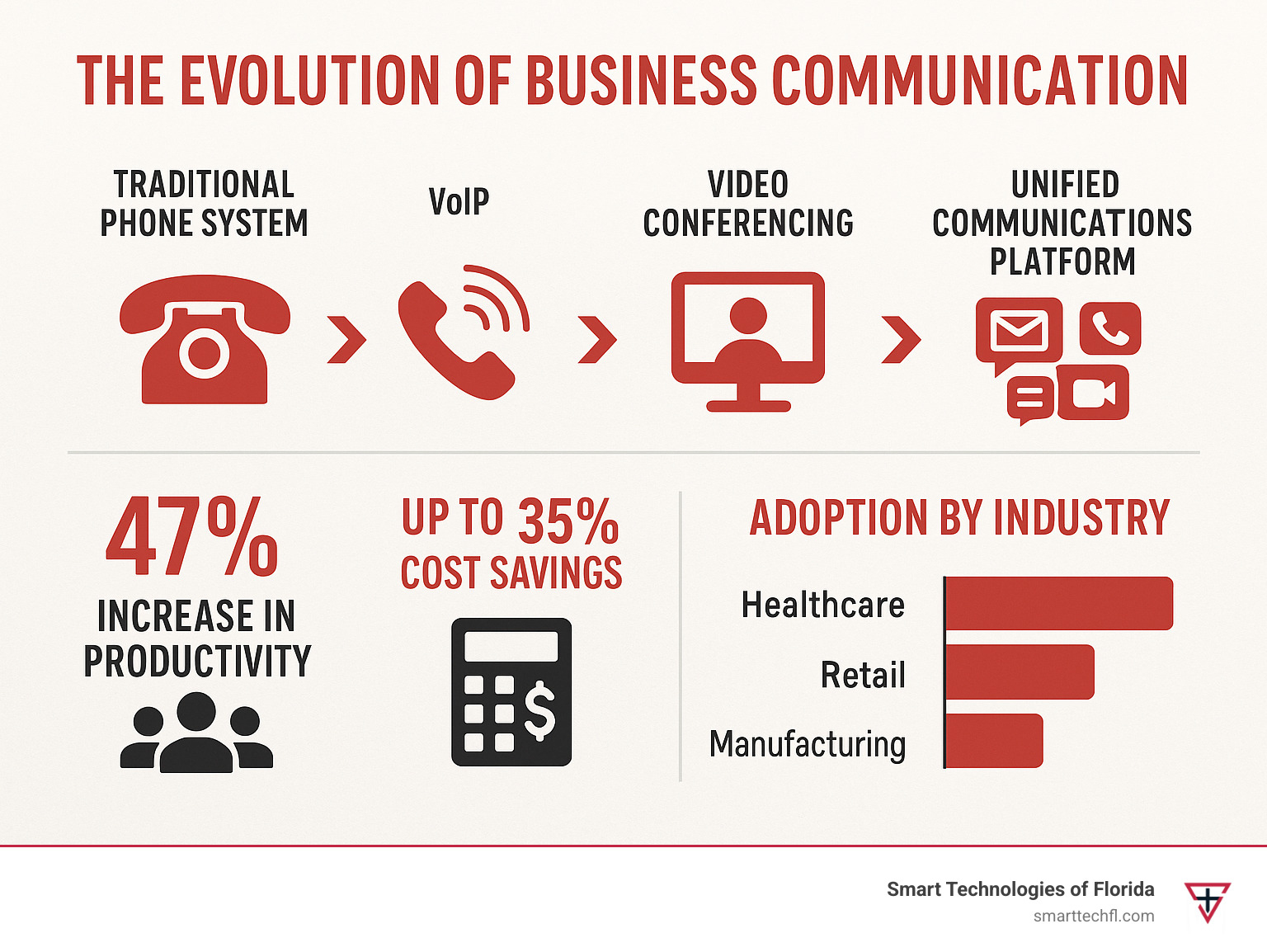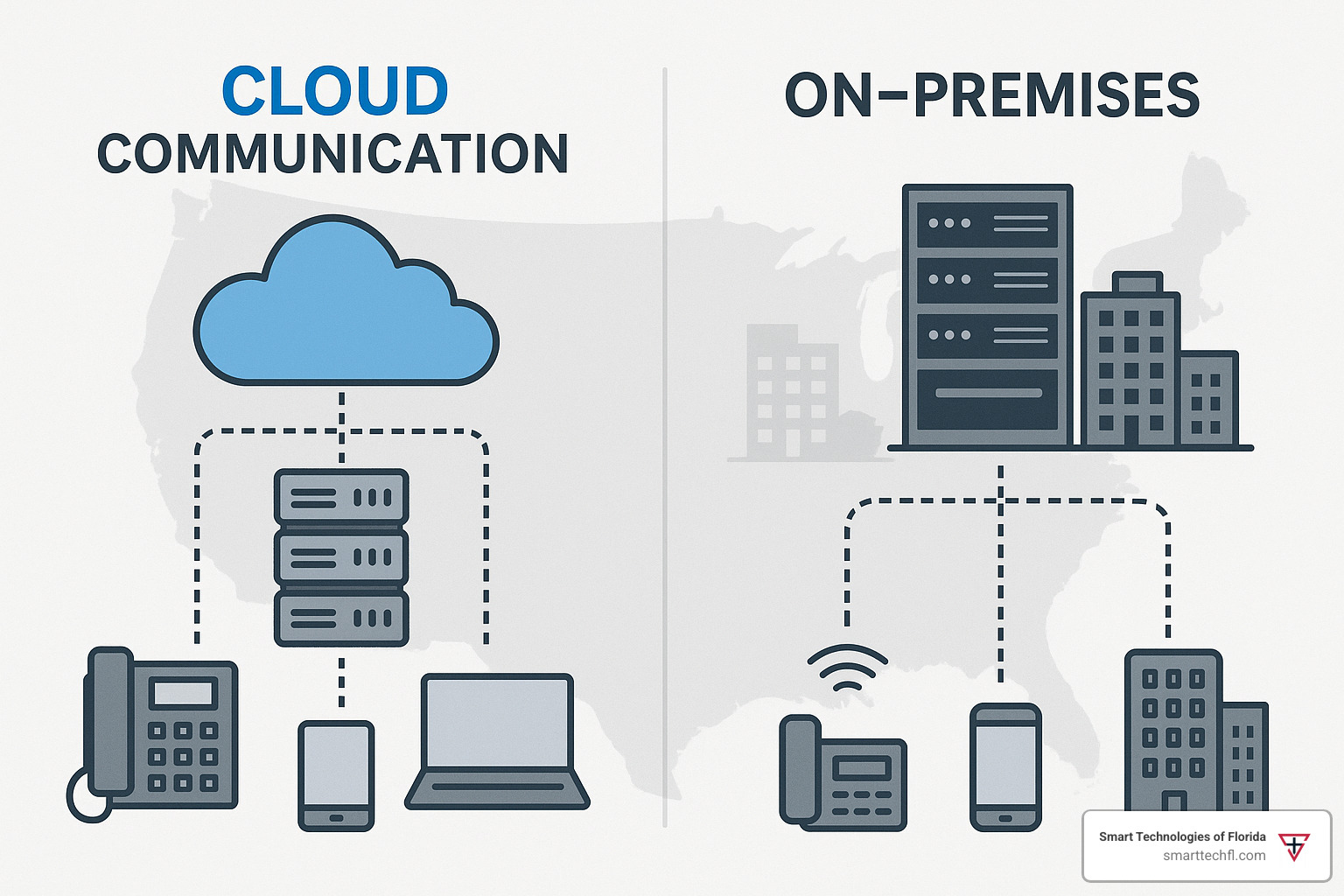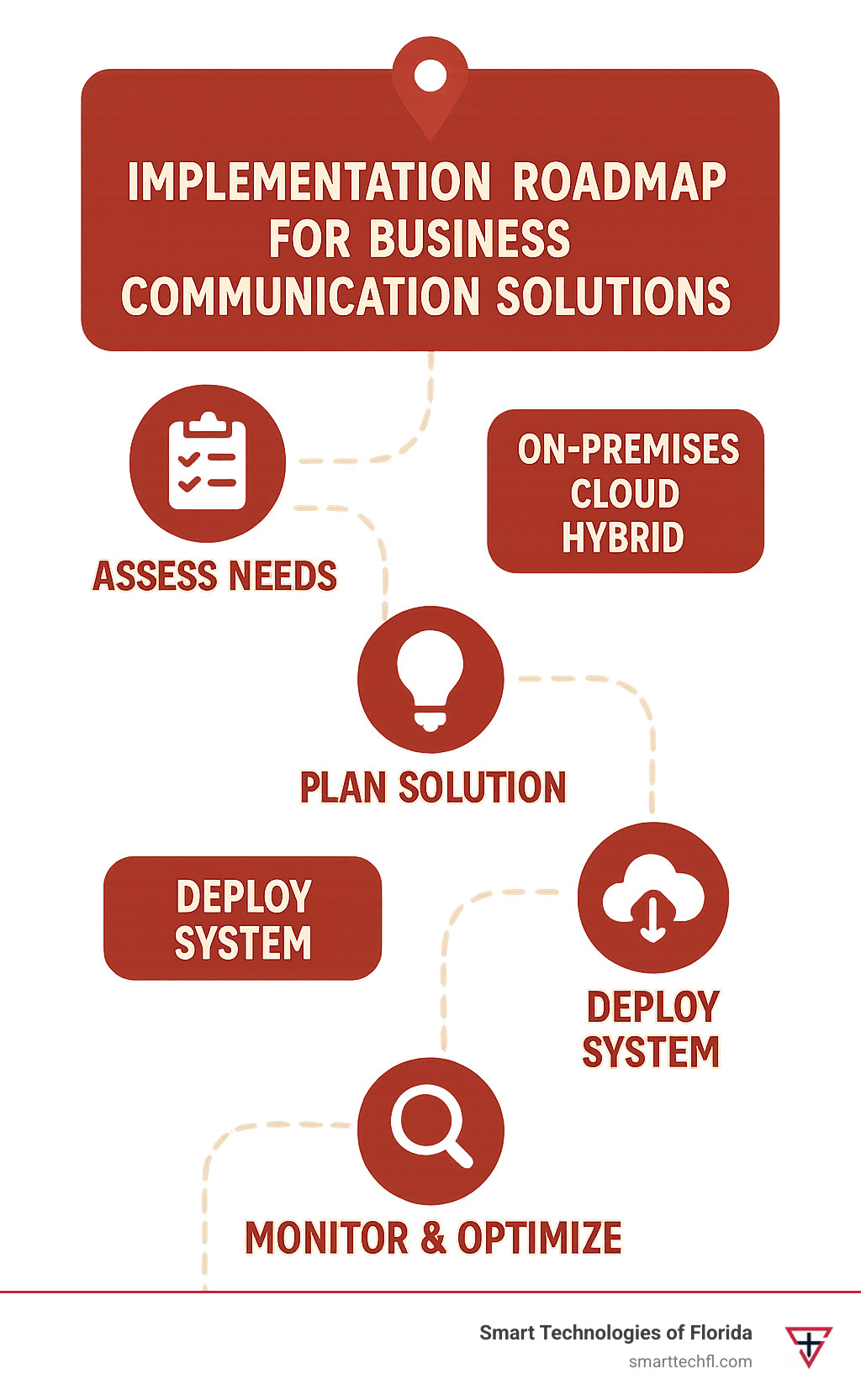The Ultimate Guide to Business Communication Solutions
Business communication solutions are the technologies, platforms, and services that enable efficient information exchange within organizations and with external stakeholders. If you’re looking for ways to improve how your team communicates, here’s what you need to know:
| Type of Solution | Primary Function | Best For |
|---|---|---|
| Unified Communications | Integrates voice, video, messaging | Mid to large businesses |
| VoIP Phone Systems | Cloud-based calling | Cost-conscious organizations |
| Team Collaboration | File sharing, project management | Remote/hybrid teams |
| Video Conferencing | Face-to-face virtual meetings | Distributed workforces |
| Contact Center Solutions | Customer communication management | Customer service teams |
In this rapidly evolving business landscape, effective communication has become the backbone of organizational success. The way we connect, collaborate, and share information has transformed dramatically over the past decade, with digital tools replacing traditional methods at an accelerating pace.
“Communication should complement the way a business operates, not force the business to adapt to the technology,” as one industry expert notes. This philosophy underscores why choosing the right communication solutions is so critical.
For retail businesses specifically, the right communication tools can streamline operations between store locations, improve customer service response times, and create more efficient inventory management. When your team can communicate seamlessly, both internally and with customers, you gain a significant competitive advantage.
The COVID-19 pandemic permanently altered workplace communication, with remote and hybrid work models becoming standard rather than exceptional. This shift has made robust, flexible communication platforms essential rather than optional for businesses of all sizes.
According to recent statistics, organizations using modern communication solutions report:
- 47% increase in team productivity
- Up to 35% time saved through automation
- Significant cost reductions compared to legacy systems
Whether you’re looking to replace an outdated phone system, implement team collaboration software, or create a comprehensive unified communications strategy, understanding the fundamentals will help you make informed decisions that align with your business goals.

What Are Business Communication Solutions & Why They Matter
Have you ever stopped to think about how your team shares information throughout the day? Business communication solutions are the heartbeat of modern workplaces – they’re the tools, technologies, and services that keep information flowing within your organization and with your customers.
Gone are the days when a desk phone was all you needed. Today’s communication landscape is rich with possibilities that can transform how your business operates and grows.
At Smart Technologies of Florida, we’ve spent 23 years watching businesses flourish when they find the right communication tools. The perfect business communication solutions don’t just connect people – they boost productivity, deepen customer relationships, and create flexibility for your team whether they’re in the office, at home, or on the go.
Core components of communication platforms
The best business communication solutions work together like a well-rehearsed orchestra, with each component playing its essential part:
Voice systems have evolved dramatically – from traditional phone setups to cloud-based VoIP solutions that let your team make calls from any device, anywhere. That sales rep catching a flight? They can still handle important client calls without missing a beat.
Video platforms bring faces and expressions into conversations, making remote interactions feel personal and meaningful. Those subtle nods of understanding or flashes of inspiration don’t get lost in translation.
Messaging systems keep conversations flowing throughout the day, whether through team chats, direct messages, or text communications with clients. Quick questions get quick answers without the formality of scheduled meetings.
Collaboration tools create shared spaces where your team can work together on documents, track projects, and organize information so nothing falls through the cracks.
And tying it all together is the cloud infrastructure that makes these tools accessible wherever your team members happen to be working today.
Benefits for growing organizations
For businesses on the rise, solid business communication solutions deliver game-changing advantages:
When your tools work seamlessly together, efficiency soars. No more hunting through email chains or switching between five different apps to find what you need – everything flows naturally through integrated systems.
Decision-making accelerates when information moves freely. That project that used to stall waiting for input? Now feedback comes in real-time, keeping momentum strong.
Perhaps most importantly, employee experience improves dramatically. As one of our Daytona Beach clients told us, “Once we implemented a unified communication platform, our team’s ability to collaborate improved dramatically. Projects that used to take weeks now wrap up in days.”
Key advantages of business communication solutions today
Modern business communication solutions offer concrete benefits that legacy systems simply can’t match:
Cost reduction is a major win – cloud-based solutions typically slash total ownership costs by 30-50% compared to traditional on-premises systems. Those savings can be redirected to growth initiatives or improving customer experiences.
Mobility isn’t just a nice-to-have anymore. Today’s workforce expects the flexibility to work effectively from anywhere, and modern communication tools make that possible without sacrificing productivity.
Customer satisfaction gets a significant boost when your team can respond quickly and personally across any channel. When a customer reaches out, the right information and context are immediately available to provide excellent service.
It’s no wonder that over 80% of Fortune 100 companies have acceptd modern communication platforms, with businesses of all sizes following their lead at an accelerating pace.
Ready to learn more about how the right communication tools can transform your business? Explore our comprehensive guide to communication solutions for deeper insights.
Types of Modern Communication Solutions & How to Choose
The landscape of business communication solutions has diversified significantly, offering specialized tools for different organizational needs. Understanding the strengths of each solution type is crucial for making informed decisions.

Unified communications platforms
Unified Communications (UC) platforms represent the most comprehensive approach to business communication solutions. Think of them as the Swiss Army knife of business communication – they bring together voice, video, messaging, and collaboration tools into one seamless experience.
When your team uses a unified platform, they’ll enjoy real-time presence information that shows who’s available at a glance. Conversations flow naturally from chat to voice to video without disruption, and that meeting you started on your laptop can continue seamlessly on your phone when you need to step away from your desk.
What really makes UC shine is how it connects with your other business systems. Imagine clicking on a customer’s name in your CRM and immediately being able to call them – that’s the power of integration at work.
Our clients often tell us that implementing unified communications was like removing invisible barriers they didn’t even know existed. One Florida retailer told us, “Our team feels more connected now than when we were all in the same building.”
More info about Unified Communications
Cloud-based phone & VoIP systems
Remember when adding a new phone line meant waiting for the phone company to send a technician? Those days are thankfully behind us. Modern VoIP systems form the backbone of today’s business communication solutions, transmitting calls over the internet rather than traditional copper lines.
The benefits are substantial – most businesses save 30-50% compared to traditional phone systems. But the advantages go far beyond cost. Need to add a line for your new hire? It takes minutes, not days. Working from home or visiting clients in Orlando? Your office phone can ring wherever you are.
VoIP systems also bring sophisticated features that once required expensive equipment: automatic call routing, voicemail delivered to your email, virtual receptionists that direct calls, and detailed analytics about your communication patterns.
A local Daytona Beach accounting firm recently told us, “Our clients can’t tell if we’re answering from the office, home, or the beach – they just know we’re always accessible.” That’s the flexibility modern communication provides.
More info about VoIP Business Solutions
Messaging, file sharing & automation layers
Today’s business communication solutions extend far beyond just talking. Modern messaging platforms have evolved into collaboration hubs where work actually happens.
Thread-based conversations keep topics organized and searchable. Document sharing happens in real-time, with everyone seeing the latest version. And when these systems connect with your other business tools through APIs, the magic really happens – imagine a customer inquiry automatically creating a support ticket, or a sales chat triggering an update in your CRM.
The real game-changer is how these tools reduce email overload. As one client put it, “We’ve cut our internal email by 70% since implementing team messaging.” Information flows more naturally, decisions happen faster, and work simply feels less frustrating.
Security remains paramount, especially for our Florida healthcare and financial clients. Modern messaging platforms offer end-to-end encryption, compliance features, and granular permission controls to keep sensitive information protected.
Selecting the right business communication solutions for your team
Choosing the right business communication solutions isn’t about chasing the newest features – it’s about finding technology that complements how your team actually works. We’ve seen too many businesses invest in powerful systems that sit unused because they didn’t match real-world workflows.
User adoption is the make-or-break factor for any new system. The most sophisticated platform in the world won’t help if your team finds it frustrating to use. Look for intuitive interfaces that feel familiar and require minimal training.
Consider how your business might grow, too. The system that perfectly fits your 15-person team today might become a limitation when you reach 50 employees. Scalable solutions grow with you without requiring a complete replacement.
Budget planning requires looking beyond the initial price tag. A seemingly expensive solution might deliver substantial ROI through improved productivity and reduced maintenance costs, while a “bargain” system could cost more in the long run through inefficiency and frustration.
At Smart Technologies of Florida, we often tell clients, “Your communication tools should feel like they were designed specifically for your business.” After 23 years of helping Florida organizations transform their communication, we’ve learned that the best technology is the kind you barely notice because it just works.
For more information about selecting the right communication tools, check out this comprehensive guide to business communication from Wikipedia.
Cloud vs On-Premises Communication Architectures
When implementing business communication solutions, one of the most fundamental decisions is choosing between cloud-based and on-premises architectures. Each approach offers distinct advantages and considerations.

Advantages of cloud-hosted systems
The shift toward cloud-based business communication solutions isn’t just a trend – it’s a change that’s reshaping how businesses connect. And for good reason!
When you move your communications to the cloud, you’re essentially trading the headaches of hardware management for the freedom of flexibility. Imagine implementing new systems in days rather than months, with your team accessing tools from anywhere with an internet connection. No more “I’ll handle that when I get to the office” – just seamless productivity.
Perhaps what our clients appreciate most is the peace of mind that comes with automatic updates. Your system continuously improves without IT intervention, always equipped with the latest features and security patches. And when disaster strikes (Florida weather, anyone?), built-in redundancy ensures your communications remain uninterrupted.
From a financial perspective, the subscription-based pricing model converts unpredictable capital expenses into manageable operational costs you can budget for. The reliability metrics speak volumes too – leading providers maintain 99.999% uptime, which translates to less than 5.26 minutes of downtime annually. That’s reliability most on-premises solutions simply can’t match.
When on-premises still makes sense
Despite the cloud’s compelling advantages, sometimes keeping your business communication solutions on-site still makes perfect sense.
For businesses operating under strict regulatory frameworks, maintaining physical control over communication systems might be non-negotiable. We’ve worked with healthcare organizations in Daytona Beach whose compliance requirements made on-premises solutions the more suitable choice.
If you’ve invested significantly in legacy infrastructure, integrating with existing systems might be more straightforward with on-premises solutions. Some specialized industries with microsecond response time requirements benefit from the reduced latency of local deployments.
And let’s not forget the control factor. For organizations with unique IT needs or specialized security protocols, having direct management over every aspect of your communication infrastructure provides a level of customization that some businesses still prefer.
Hybrid approaches bridging both worlds
In our 23 years of experience, we’ve found that most organizations don’t need to make an all-or-nothing choice. Hybrid business communication solutions offer a thoughtful middle ground that combines the best aspects of both approaches.
Think of hybrid solutions as building a bridge between your current infrastructure and future capabilities. You can maintain existing investments while strategically adding cloud capabilities where they make the most sense. This approach creates a sensible migration path, allowing you to transition gradually from legacy to cloud systems.
Many of our clients appreciate the flexibility of a phased rollout – perhaps moving customer service to cloud platforms first while keeping executive communications on-premises. This balanced approach lets you optimize costs while testing new capabilities in controlled environments.
As one of our manufacturing clients in Central Florida put it: “The hybrid model gave us breathing room to adapt at our own pace, without sacrificing the reliability we needed for day-to-day operations.”
More info about Cloud Communication
Implementing, Securing & Integrating Your Communication Stack
Bringing new business communication solutions into your organization is a bit like renovating your home while you’re still living in it—it takes careful planning, attention to detail, and a focus on making the transition as smooth as possible for everyone involved.

Security & compliance essentials
Let’s face it—in today’s digital world, security isn’t optional, it’s fundamental. When implementing business communication solutions, think of security as the foundation of your house, not just a fancy lock on the front door.
End-to-end encryption ensures your business conversations remain private from start to finish—like having a conversation in a soundproof room rather than shouting across a crowded restaurant. We’ve seen too many organizations learn this lesson the hard way.
Multi-factor authentication adds that crucial extra layer of protection beyond passwords. It’s like having both a key and a security code for your office—much harder for unwanted visitors to get past.
When it comes to compliance frameworks, your communication systems need to play by the rules that govern your industry. Whether that’s HIPAA for healthcare providers in Daytona Beach or GDPR for companies working with European clients, your systems should make compliance easier, not harder.
Audit trails might not sound exciting, but they’re incredibly valuable—like having security cameras that let you review exactly who accessed what and when. They’re not just for catching problems; they’re proof that you’re doing things right.
Integration with existing tools
The real magic of modern business communication solutions happens when they work seamlessly with your other business tools. Think of it as all your business applications finally learning to speak the same language.
When your communications connect with your CRM system, customer interactions become infinitely more valuable. Your team can see a customer’s entire history while talking to them—no more putting people on hold while you hunt down their information in another system.
Connecting to ticketing systems means support requests don’t fall through the cracks. A customer mentions an issue during a call, and boom—it’s already in your ticketing system, assigned and tracked.
Analytics integration gives you the power to see patterns you might otherwise miss. Which communication channels do your customers prefer? When are your busiest periods? These insights help you staff appropriately and focus your resources where they matter most.
Perhaps most exciting is workflow automation—having your communication tools trigger actions in other systems automatically. It’s like having a digital assistant who takes care of the routine stuff so your team can focus on what humans do best: building relationships and solving complex problems.
Change management for business communication solutions
Here’s a truth we’ve learned over 23 years at Smart Technologies of Florida: the best technology in the world fails without proper change management. New tools require new habits, and humans are creatures of habit.
User adoption doesn’t happen by accident. It takes thoughtful training, internal champions who can help their colleagues, and sometimes even incentives to encourage people to accept new ways of working. We often tell clients that training isn’t a one-time event but an ongoing process.
Creating feedback loops ensures you catch and address issues early. Regular check-ins with users help you understand what’s working and what isn’t—and show your team that their experience matters.
Tracking key performance indicators helps you measure success beyond just “is it working?” Are response times improving? Are customers more satisfied? Is internal collaboration increasing? These metrics tell the real story of your implementation’s success.
The best implementations accept continuous improvement—they evolve based on how people actually use the tools, not just how they were designed to be used. Sometimes the most valuable features are finded by users, not planned by designers.
More info about Business Communication Services
Measuring ROI & Emerging Trends in Business Communication
Investing in business communication solutions is a big step for any organization. But how do you know if that investment is paying off? And what’s coming around the corner that might change everything again? Let’s explore both the dollars-and-cents reality of measuring your return and the exciting innovations reshaping how we connect at work.

Calculating total cost of ownership
When we sit down with clients at Smart Technologies of Florida, we often find they’ve overlooked some aspects of what their communication systems truly cost. Getting the complete picture means looking beyond the price tag to include:
License costs are just the beginning – whether you’re paying monthly subscriptions or making a one-time purchase. Hardware expenses like phones, headsets, and meeting room equipment add up quickly. Don’t forget about implementation and training costs to get everyone up to speed, plus the ongoing maintenance needed to keep everything running smoothly.
The good news? When you stack these costs against the benefits, the math usually works in your favor. Studies show the average employee saves about 97 minutes every week with better communication tools. Think about what your team could accomplish with an extra hour and a half each week!
KPIs to track performance
Numbers tell the story of success (or where you need improvement). When we help Daytona Beach businesses implement new systems, we recommend tracking these key metrics:
Response time shows how quickly your team members get back to each other and customers – a direct measure of improved efficiency. Call resolution rates reveal whether you’re solving customer problems in one interaction instead of multiple callbacks. Employee engagement metrics help you understand if your team actually likes using the new tools (crucial for adoption!).
We also track system utilization across different channels to see which tools your team prefers, and customer satisfaction scores to measure the external impact of your improved internal communication. One client saw their customer satisfaction jump 18% within three months of implementing their new business communication solution – a clear sign they were on the right track.
Future-proofing your business communication solutions
The communication landscape never stands still. What seems cutting-edge today might be standard tomorrow. Here’s what we’re excited about for the future:
AI assistants are changing how we handle routine communication tasks. Imagine having a digital helper that summarizes your two-hour meeting into key action items or suggests responses to common customer questions.
5G connectivity isn’t just about faster phones – it’s enabling entirely new ways to connect, especially for businesses with field workers or multiple locations. One construction client tells us their on-site video collaboration has completely transformed how they handle project challenges.
Immersive meetings using virtual and augmented reality are making remote collaboration feel more natural and engaging. Voice intelligence is turning conversations into searchable, analyzable data. And hyper-personalization is creating communication experiences that adapt to each person’s work style and preferences.
At Smart Technologies of Florida, we love helping our clients stay ahead of these trends. We focus on implementing flexible platforms that can grow and evolve as new capabilities emerge – because the last thing you want is to invest in a system that feels outdated before you’ve finished paying for it.
More info about Enterprise Communications Tools
Frequently Asked Questions about Business Communication Solutions
Let’s tackle some of the most common questions we hear from businesses considering new communication tools. After helping hundreds of companies in Daytona Beach and beyond upgrade their systems, these are the concerns that come up most frequently.
What security standards should my solution meet?
Security is never a place to cut corners. Your business communication solutions need protection that matches both your industry requirements and the sensitivity of your conversations.
At minimum, look for systems that offer end-to-end encryption—this ensures your messages remain private from the moment they leave your device until they reach their destination. For cloud services, SOC 2 compliance demonstrates that the provider follows strict information security policies.
If you’re in healthcare, HIPAA compliance isn’t optional—it’s essential. Similarly, companies interacting with European customers need GDPR-compliant tools. And regardless of your industry, regular security audits provide peace of mind that your systems remain protected against evolving threats.
As we often tell our clients at Smart Technologies of Florida, your communication platform should be at least as secure as your most sensitive business systems. After all, your team’s conversations often contain the very information those systems are designed to protect.
How long does migration typically take?
“How soon can we be up and running?” is usually the second question we hear after “How much will it cost?” The honest answer is: it depends on several factors.
For a small business with straightforward needs, we can often complete migration to new business communication solutions in as little as 4 weeks. Mid-sized organizations typically require 6-8 weeks, while enterprise-level implementations may extend to 6 months or beyond.
What affects this timeline? Your organization’s size is obvious, but equally important are:
- The complexity of your desired solution
- How deeply embedded your legacy systems are
- How much user training your team will need
We’ve found that the most successful migrations aren’t necessarily the fastest ones. Taking time for proper planning and thorough training pays dividends in user adoption and satisfaction. When we work with clients at Smart Technologies of Florida, we provide detailed project timelines during the planning phase, so expectations are clear from day one.
How can I estimate cost savings?
This is where things get exciting. New business communication solutions often deliver impressive ROI through multiple channels.
Start with the obvious: compare your current phone bills, maintenance contracts, and hardware costs against the new solution’s total cost of ownership. But that’s just the beginning.
The real magic happens in productivity improvements. Studies consistently show 35-47% productivity gains with modern communication tools. To translate this to dollars, multiply the average hourly wage by the time saved per employee—the numbers add up quickly.
Many of our clients are also realizing significant savings in real estate costs as better remote work capabilities allow them to reduce office space. And with improved virtual collaboration, business travel expenses often decrease dramatically too.
One client in Daytona Beach was skeptical about our projected savings until they calculated them six months after implementation. Their new communication platform had paid for itself entirely, and they were on track to save over $200,000 annually going forward.
Most organizations we work with at Smart Technologies of Florida find their new systems pay for themselves within 12-18 months—making the decision to upgrade less about cost and more about when to start realizing these benefits.
More info about Business Communication Solutions
Conclusion
Remember when business communication meant desk phones and fax machines? Those days are long gone! In today’s digital world, robust business communication solutions aren’t just nice to have—they’re the lifeblood of successful organizations.
Throughout our journey together in this guide, we’ve seen how modern communication tools do much more than just connect people. They transform entire workflows, breathe new life into team collaboration, and create those magical moments of customer delight that keep people coming back.
I’ve spent countless hours with businesses in Daytona Beach who thought they were “getting by” with outdated systems, only to see their eyes light up when they experience what today’s solutions can do. The right communication platform feels less like adopting new technology and more like removing the obstacles that have been holding your team back all along.
At Smart Technologies of Florida, our 23 years in this field have taught us one crucial lesson: technology should work for people, not the other way around. When communication tools align with how your team naturally works, the magic happens without forcing anyone to change their fundamental approach.
Here’s what I hope you’ll take away from our conversation:
Your communication solutions should feel like they were built specifically for your business—because when implemented correctly, they essentially are. Cloud systems offer remarkable flexibility and cost benefits, but they need to be selected with your specific workflows in mind. Security isn’t something to bolt on later—it needs to be woven into the fabric of your communication strategy from day one. And perhaps most importantly, the real value comes when your communication tools talk to your other business systems, creating a seamless experience for everyone.
Measuring success isn’t just about feeling better—though that certainly happens! Track specific metrics like response times and customer satisfaction to see exactly how your investment is paying off. These numbers tell a powerful story when it’s time to justify your technology decisions.
I always remind our clients that successful implementation is about the journey, not just the destination. The most sophisticated communication platform in the world won’t help if your team doesn’t accept it. That’s why we put so much emphasis on the human side of technology adoption—helping your people see these tools as allies rather than obstacles.
Ready to transform how your team connects, collaborates, and creates? Learn more about our Business Communication Solutions or reach out for a conversation about your unique challenges. We’re real people who love helping other real people do amazing things with the right technology.
After all, in a world of digital change, the human touch still matters most. That’s something we at Smart Technologies of Florida will never forget.












